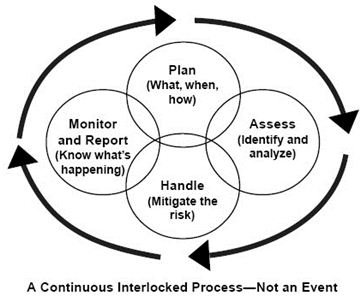Different Methods of Risk Analysis
Three Methods of Risk Analysis
Managing projects without addressing the fundamental risks that threaten them can be disastrous. To help with the analysis of risk as part of project
management, frameworks have been developed that help provide structure for the process. Three methods of risk analysis are introduced below that will help readers learn more about risk analysis.
Image Credit: Wikimedia Commons/Magnus Manske
Risk Analysis and Management of Projects (RAMP)
The Risk Analysis and Management of Projects (RAMP) method of risk assessment was developed in the United Kingdom. It works to document and reduce the impact of risk using the framework defined for the project as those risks are incurred by the project.
During RAMP assessment analysis is scheduled throughout the life cycle of a project and tends to focus on financial concerns as impacted by project uncertainty. According to Ward and Chapman, it is the association of financial issues with project risk that differentiates RAMP from other frameworks.
RAMP approaches risk on several levels and combined elements from other frameworks to codify four actions that include the launch of a project, a systematic review of uncertainties that affect the project, management of risk, and project termination.
The stages of RAMP involve the identification of risks to the project, an analysis of the impact of those risks and their likelihood, an enumeration of the options available for addressing those risks. RAMP calls for the mitigation of uncertainties that affect the project and the control of factors that cannot be adequately addressed.
Because RAMP was designed with actuarial interests, it is geared toward the appraisal of projects in light of the uncertainties they face.
Shape, Harness, And Manage Project Uncertainty (SHAMPU)
Another important method of risk assessment is Shape, Harness, And Manage Project Uncertainty (SHAMPU). This is a generic framework that consists of nine steps (define, focus, identify, structure, ownership, estimate, evaluate, plan, and manage) for assessing the risk organized by the outline set forth in the acronym as follows.
Shape. Express the foundation of risk assessment by defining and focusing the project. An effective strategic view of the project will shape the approach the project manager takes to uncertainty. By influencing project strategy with risk management in mind, the entire project will be efficiently shaped in a way that provides for the natural assessment of risk.
This stage also includes the analysis of the quality of risks affecting the project. Here the uncertainties are identified, categorized, and assigned to specific owners.
Finally, the shape phase of risk assessment calls for the estimation of the variability of risk and the evaluation of their implications.
Harness. This stage of risk assessment is tactical and leverages the strategic shape of risk assessment and the “six W’s” to get a handle on identifying risk in ways that complement the strategic plan.
Manage. Once the tactical plan is in place management is needed to address uncertainty relevant to the project throughout its life cycle.
SHAMPU is a generic framework for risk assessment and is a good starting point for those who are getting started with project planning with the principles of risk assessment in mind. Experienced managers and organizations can adapt SHAMPU to existing practices to customize risk assessment according to situational requirements.
Risk Factor Analysis (RFA)
Risk Factor Analysis (RFA) is one of the many methods of risk analysis that follows a qualitative approach. This type of system is a comprehensive way to identify factors that can affect the quality of the outcome of a project while helping managers get new perspectives that can help them survive qualitative risks.
RFA is a flexible system that can be adapted to a wide variety of scenarios with differing qualitative risks. Examples of uncertainties that RFA may deal with include risks that affect project cost such as labor and materials and scheduling such as the availability of facilities and personnel. Technical risks that involve the maturity level of technology applied to the project.
Another common example of uncertainty that RFA looks at is that of financial resources. These might include the vulnerability of funding for various project tasks or the inability to gain sufficient funding to complete the project.
Once every uncertainty is ranked and totaled for each category of risk, potential strategies for reducing risk are developed.
References
Chapman, C. B.; Ward, Stephen. Project Risk Management : Processes, Techniques, and Insights. Hoboken, NJ John Wiley & Sons, Ltd. (UK), 2003.
“RAMP – Risk Analysis and Management for Projects”, https://www.zurich.co.uk/NR/rdonlyres/E0E97535-DD8D-4B72-910C-D05DA0AA52BD/0/RAMPInformation.pdf
“Risk Factor Analysis–A New Qualitative Risk Management Tool”, www.lanl.gov/orgs/d/d5/documents/risk-fact.pdf
